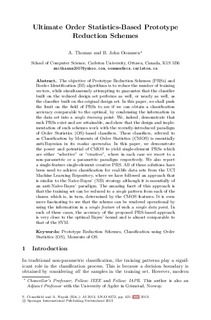| dc.contributor.author | Thomas, Anu | |
| dc.contributor.author | Oommen, B. John | |
| dc.date.accessioned | 2014-01-16T12:24:35Z | |
| dc.date.available | 2014-01-16T12:24:35Z | |
| dc.date.issued | 2013 | |
| dc.identifier.citation | Thomas, A., & Oommen, B. J. (2013). Ultimate Order Statistics-Based Prototype Reduction Schemes. In S. Cranefield & A. Nayak (Eds.), AI 2013: Advances in Artificial Intelligence (Vol. 8272, pp. 421-433): Springer. | no_NO |
| dc.identifier.uri | http://hdl.handle.net/11250/138024 | |
| dc.description | Published version of a chapter in the book: AI 2013: Advances in Artificial Intelligence. Also available from the publisher at: http://dx.doi.org/10.1007/978-3-319-03680-9_42 | no_NO |
| dc.description.abstract | The objective of Prototype Reduction Schemes (PRSs) and Border Identification (BI) algorithms is to reduce the number of training vectors, while simultaneously attempting to guarantee that the classifier built on the reduced design set performs as well, or nearly as well, as the classifier built on the original design set. In this paper, we shall push the limit on the field of PRSs to see if we can obtain a classification accuracy comparable to the optimal, by condensing the information in the data set into a single training point. We, indeed, demonstrate that such PRSs exist and are attainable, and show that the design and implementation of such schemes work with the recently-introduced paradigm of Order Statistics (OS)-based classifiers. These classifiers, referred to as Classification by Moments of Order Statistics (CMOS) is essentially anti-Bayesian in its modus operandus. In this paper, we demonstrate the power and potential of CMOS to yield single-element PRSs which are either “selective” or “creative”, where in each case we resort to a non-parametric or a parametric paradigm respectively. We also report a single-feature single-element creative PRS. All of these solutions have been used to achieve classification for real-life data sets from the UCI Machine Learning Repository, where we have followed an approach that is similar to the Naïve-Bayes’ (NB) strategy although it is essentially of an anti-Naïve-Bayes’ paradigm. The amazing facet of this approach is that the training set can be reduced to a single pattern from each of the classes which is, in turn, determined by the CMOS features. It is even more fascinating to see that the scheme can be rendered operational by using the information in a single feature of such a single data point. In each of these cases, the accuracy of the proposed PRS-based approach is very close to the optimal Bayes’ bound and is almost comparable to that of the SVM. | no_NO |
| dc.language.iso | eng | no_NO |
| dc.publisher | Springer | no_NO |
| dc.relation.ispartofseries | Lecture Notes in Computer Science;8272 | |
| dc.subject | Prototype Reduction Schemes | no_NO |
| dc.subject | classification using Order Statistics (OS) | no_NO |
| dc.subject | moments of OS | no_NO |
| dc.title | Ultimate Order Statistics-Based Prototype Reduction Schemes | no_NO |
| dc.type | Chapter | no_NO |
| dc.type | Peer reviewed | no_NO |
| dc.subject.nsi | VDP::Mathematics and natural science: 400::Information and communication science: 420::Algorithms and computability theory: 422 | no_NO |
| dc.source.pagenumber | 421-433 | no_NO |
| dc.identifier.doi | 10.1007/978-3-319-03680-9_42 | |
